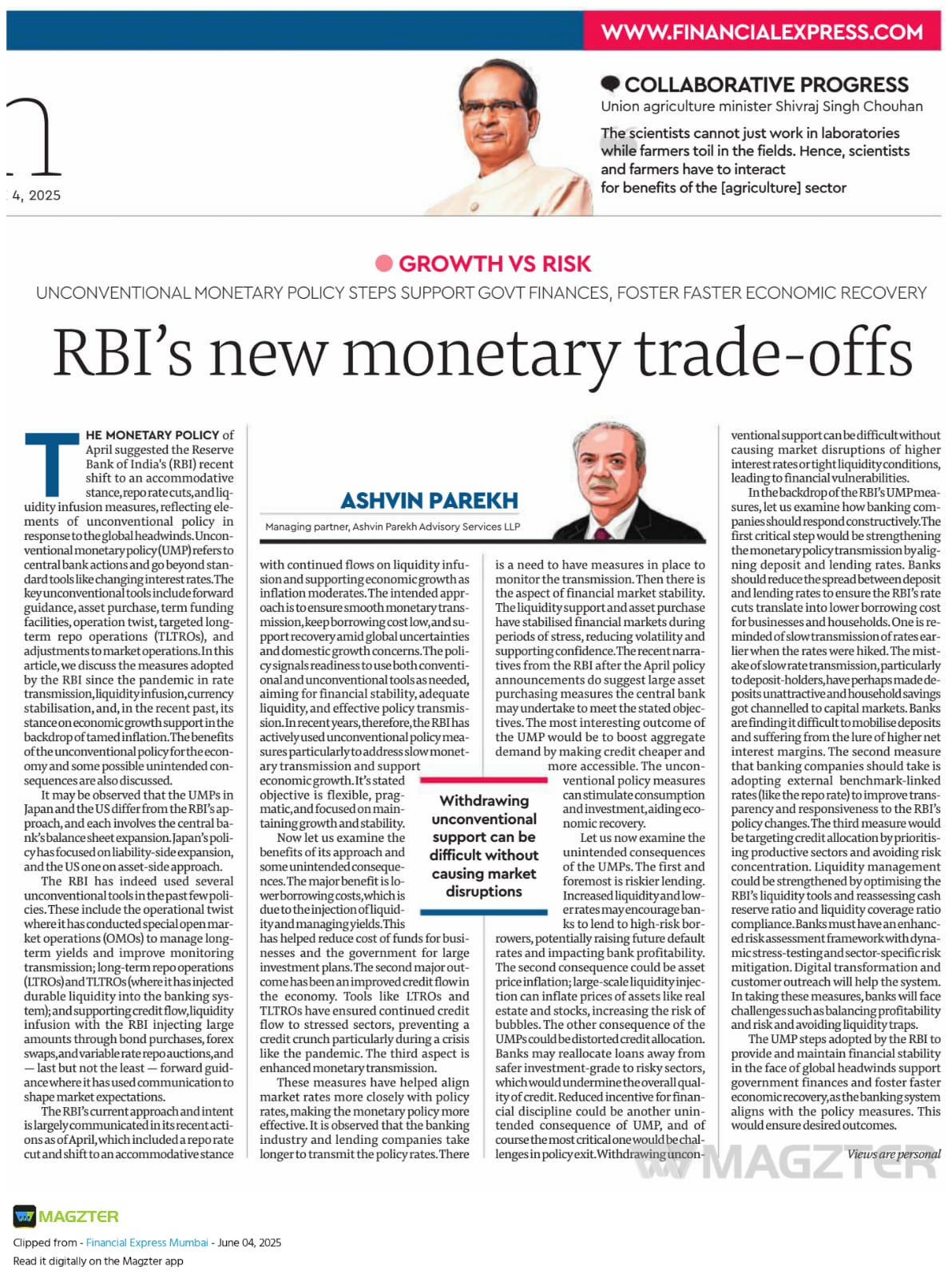by APAS Team
Share
by APAS Team
Share

January 10, 2016: In the global context, slowdown of major economies, weakening of China, plunge in manufacturing activity coupled with a steep fall in commodity prices are everyday news, and the situation is here to stay for quite some time. Amidst this turmoil, India has been the ray of hope with its sustained growth. To capitalize this trend, RBI has maintained that an effective monetary policy is vital to economic performance, among other things.
Price stability refers to avoidance of prolonged inflation and deflation and it has been foremost priority for central banks of major economies in their monetary policy. There have been claims that a loose monetary policy was one of the main factors leading to the debacle of 2008 crisis. Even though, this is debatable, it cannot be ruled out. Post crisis, there has been a renewed effort by central banks with the support of multilateral agencies in bringing more focus to monetary policy.
The monetary policy strategies utilize nominal anchor to achieve its objectives, broadly there are three types of nominal anchors 1) exchange rate 2) monetary aggregates 3) inflation. Exchange rate is considered the oldest form of nominal anchor, over the years it has lost its sheen due to the exposure of economy to external shocks and its vulnerability to speculative attacks. Monetary aggregates, referring to the total value of money supply within an economy, as an anchor, has also been burdened with instability and the unpredictability of the demand for money. Inflation as an anchor has been successful, with strong empirical and theoretical proof that low and stable inflation is a suitable condition for economic growth.
Since 1980s, central banks of several countries have adopted inflation as its nominal anchor. Inflation’s qualities of having as domestic orientation and being easily understood by the larger public, makes it stand apart even though it is believed to limit the ability to respond to financial crisis and potential instability due to supply side shocks.
Adoption of inflation targeting has helped economies move towards their goal of transparency. The benefits of inflation targeting are that with a set objective the central banks have more clarity and policies implemented are in line with the targets. Second, there is more discipline in achieving those targets and scope for evaluation by other agencies and general public. It has been considered more of a rule based approach compared to other discretionary policies and rules out decision made on individualistic beliefs.
India’s monetary policy
The Indian monetary policy has been transforming. It has undergone three major changes over the past. Prior to 1980s, the Indian economy was virtually closed and was driven by subsidies and governmental control. At that time ‘exchange rate’ was set as the nominal anchor. The formal change to ‘monetary targeting with feedback’ came in 1985 based on the recommendations of the Chakravarty Committee. In this approach, broad money became the intermediate target and reserve money the main operating instrument. During this period targets were rarely met and the major drawbacks were the absence of control of RBI’s credit to the government, which accounted for the bulk of reserve money creation.
Structural changes and the liberalization in the 1990s led to a shift in financing patterns in India. Interest and exchange rates were increasingly market determined, and the RBI could move away from direct to indirect market based instruments leading to the adoption of the ‘multiple indicator’ approach on 1st April 1998. Factors considered under this approach were money, credit, output, trade, capital flows, fiscal position, rates of return in different markets, inflation and exchange rate. Inflation was calculated using Whole sale price index (WPI). The constituents of WPI are categorized into three groups; Primary articles 20.12% (mostly food articles), Fuel &Power 14.91% and manufactured products 64.97% – Metals & Alloys, Food products, Machinery & tools etc.
This approach worked well from 1999 to 2009, as reflected in an average GDP growth rate of 7.1% associated with average inflation of about 5.5% in terms of both the CPI & WPI.
Precedence was given to WPI over CPI due to multiple reasons. First, at that point CPI was measured for four different classes: CPI – Industrial workers, Agricultural laborers, Urban non manual employee and Rural laborers and then aggregated, while WPI is computed on an all-India basis. Secondly, WPI was available with a shorter lag than the CPIs. Third, WPI had a broader coverage than the CPIs in terms of the number of commodities, quotations, inclusion of non -agricultural products etc.
But, in recent years high inflation and weakened growth came to co-exist and use of multiple indicators is highly criticized as it leaves ambiguity on what the RBI accounts while taking policy decisions. Ministry of Statistics and Programme Implementation (MOSPI) in 2012 revised CPI and is now calculated in terms of three parameters:
- CPI for the entire urban population viz CPI (Urban);
- CPI for the entire rural population viz CPI (Rural)
- CPI Combined (CPI-C) for Urban + Rural will also be compiled based on above two CPIs
The primary constituents of CPI are Food & Beverages 45.86%, Housing 10.07%, Fuel & Power 6.84%, Pan, tobacco &intoxicants 2.38%, Clothing & Footwear 6.53%, Miscellaneous 28.32%. In light of the drawbacks of multifactor approach and recommendation from the Urjit Patel Committee report, the use of inflation targeting was examined. Officially on 1st April, 2014 the RBI adopted Inflation targeting as its key strategy in monetary policy using CPI-C as the metric.
Almost all central banks in advanced and emerging economies use CPI as their primary price indicators. The widespread use of CPI as the major price indicators reflects its advantages – it is familiar to large segments of the population and often used in both public & private sector as a reference in the provision of government benefits or in wage contracts and negotiations.
The true inflation that consumers face is in the retail market, price indices that relate to the consumer expenditure are the close indicators of cost of living which is communicated by the CPI. Importantly, CPI includes cost of services, which accounts for more than 60% of India’s GDP which WPI does not. Food products also play an important role in CPI. The lag in the data release of the CPI-Combined is only 12 days as against one month for CPI-IW.
Over the years, RBI tried to adopt approaches that best reflect price movements and have embraced predictable policy framework that is rule based while leaving room for some discretion in practice.
STAY IN THE LOOP
Subscribe to our free newsletter.
The slower economic growth caused by regulatory accumulation could well [...]
Navigating the Future of Consulting: The Role of Digital Transformation [...]



